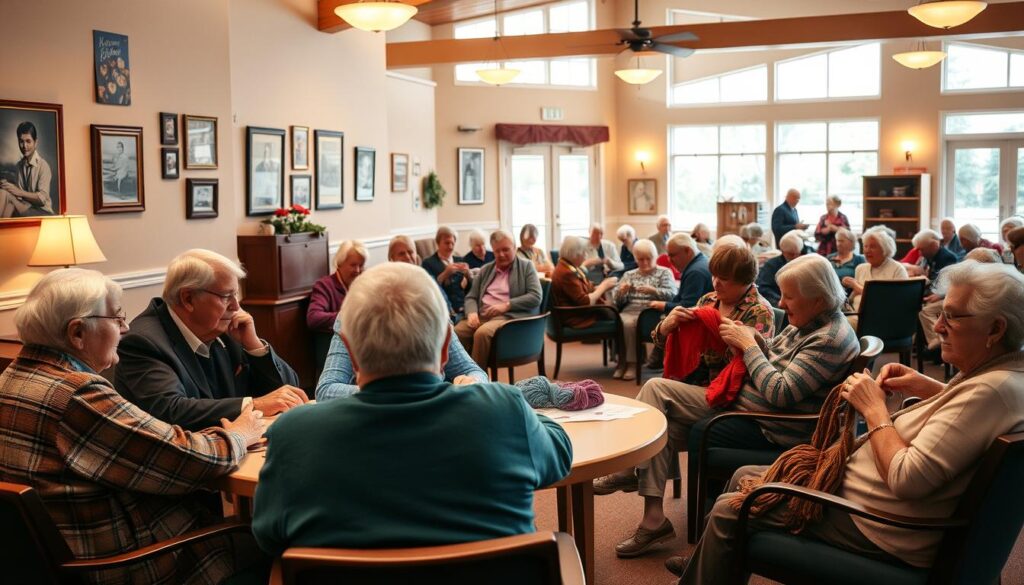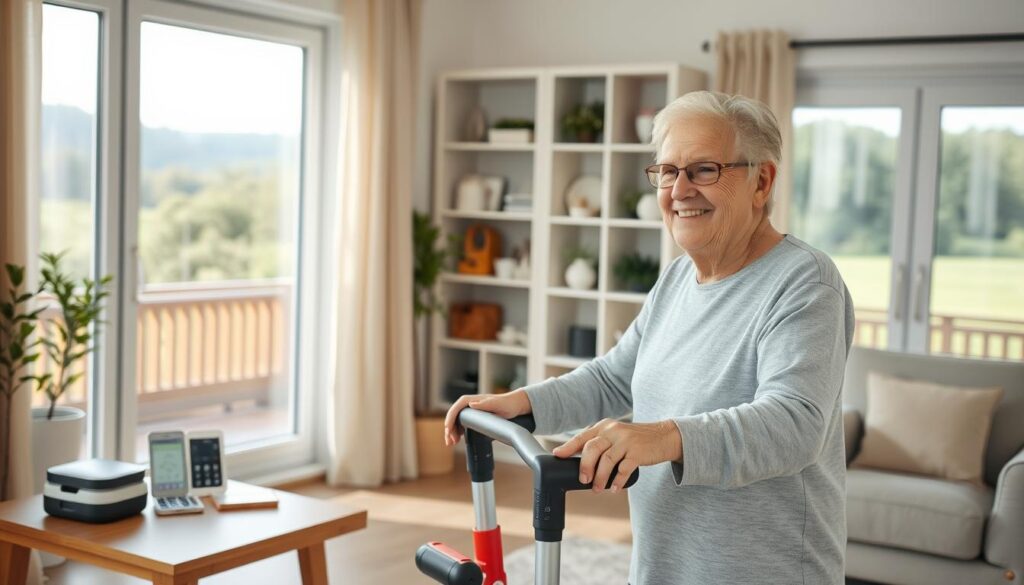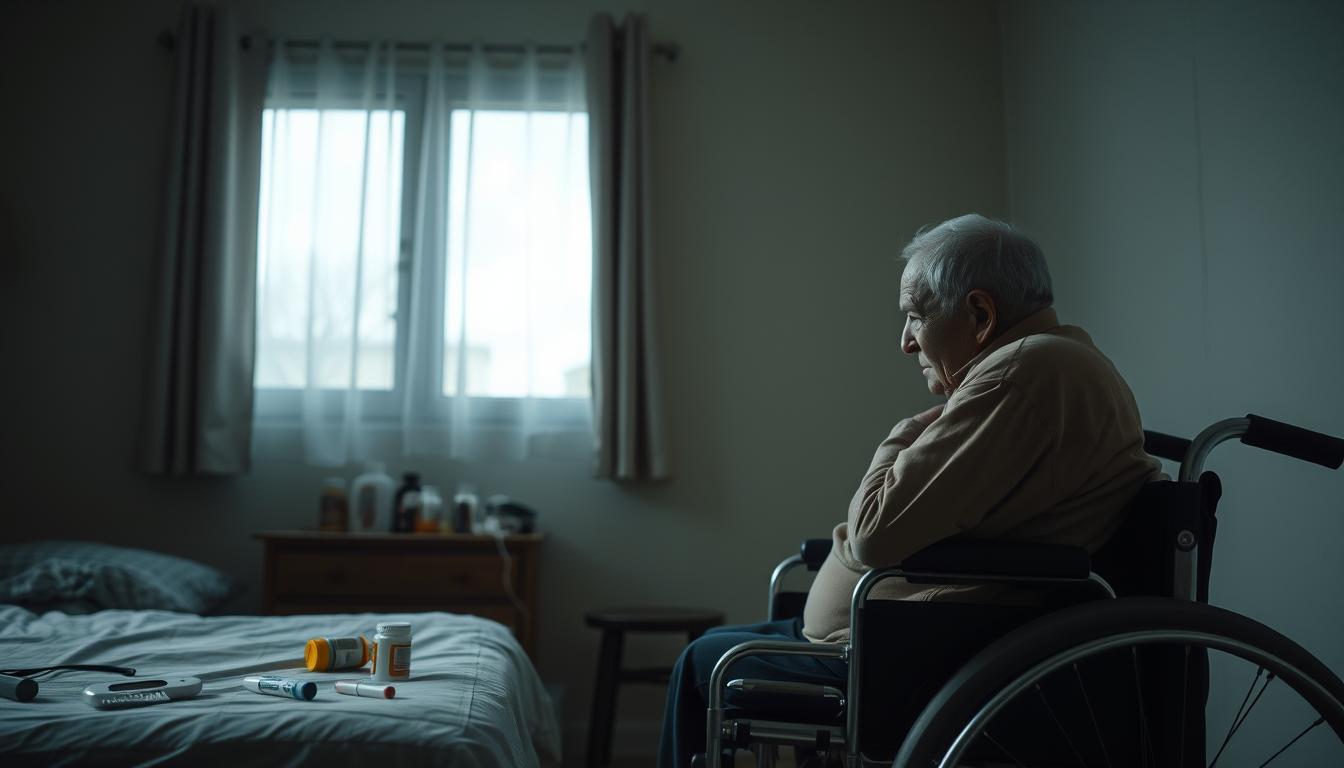Watching a grandparent slowly navigate stairs or hearing a neighbor share stories of loneliness reminds us how aging reshapes lives. These moments highlight the quiet battles many older adults face daily—struggles often hidden behind warm smiles.
Nearly 90% of adults over 60 live with at least one chronic condition, according to the National Council on Aging. Heart disease affects 37% of seniors, while mobility limitations impact 28% of older people. These numbers represent real people: parents, friends, and community members needing support.
Aging isn’t just about physical health. Emotional hurdles like isolation creep in when loved ones move away or health limits social activities. Yet hope exists. With compassionate care and practical solutions, older adults can maintain independence while managing these challenges.
Key Takeaways
- Over 90% of older adults live with chronic health conditions
- Heart disease and mobility issues rank among top physical challenges
- Emotional health requires equal attention to physical care
- Community support significantly reduces isolation risks
- Proactive care strategies improve quality of life
This article explores practical ways to address these realities, offering insights for caregivers and families committed to making golden years truly golden.
Navigating Health Challenges in Later Life
Chronic diseases shape daily routines for millions, yet smart choices can turn tides. Over 80% of adults aged 65+ manage multiple ongoing health issues, according to CDC reports. This reality demands practical solutions that empower rather than overwhelm.
When Bodies Betray: The Weight of Illness
Alzheimer’s steals memories, diabetes disrupts meals, and heart failure limits movement. These conditions create domino effects:
- Memory loss requiring constant supervision
- Blood sugar checks dictating daily schedules
- Breathlessness preventing favorite activities
Medicare data shows 1 in 3 people over 65 face cognitive decline risks. Family genetics play roles, but lifestyle choices matter more than many realize.
Fighting Back With Daily Habits
Simple changes yield big results. The National Council on Aging recommends:
- 30-minute walks five days weekly
- Colorful plates filled with veggies and lean proteins
- 7-9 hours of quality nightly sleep
“Early detection cuts complication risks by 40%,” notes a recent CDC bulletin. Regular screenings and medication reviews keep small issues from becoming crises. Loved ones and health care teams form essential support networks—their involvement often determines success.
With proper care and community backing, aging bodies can still host vibrant lives. The key lies in starting today, not tomorrow.
What do seniors struggle with the most in Daily Living
Imagine needing help to get out of bed each day—a reality for 1 in 4 people over 75. Routine activities like dressing or grocery shopping become complex puzzles when joints ache or energy fades. These hurdles test resilience while threatening the independence many cherish.
Key Areas of Difficulty
Mobility limitations affect 40% of older adults, per CDC reports. Stiff knees make climbing stairs dangerous, while shaky hands turn cooking into a risky task. Common struggles include:
- Bathing without slip hazards
- Managing medications accurately
- Accessing reliable transportation
Chronic conditions like arthritis or dementia amplify these issues. A study in the Journal of Aging Research found 68% of those with heart disease need daily assistance.
Effects on Independence
Losing the ability to perform basic tasks often leads to difficult choices. Many face moving to assisted living or relying heavily on family. “Small changes in living spaces can prevent up to 60% of falls,” notes geriatric specialist Dr. Ellen Torres.
| Challenge | Impact | Solution |
|---|---|---|
| Limited mobility | Reduces social outings | Grab bars & walkers |
| Vision decline | Difficulty reading labels | Voice-activated devices |
| Memory issues | Missed medications | Automated pill dispensers |
Regular physical therapy sessions improve strength for 73% of participants, according to AARP surveys. Family support remains crucial—simple check-ins and home safety audits preserve dignity while addressing risks.
Overcoming Technological and Digital Barriers
Technology races forward, leaving many older adults feeling like strangers in a digital world. Pew Research reveals 27% of Americans over 65 don’t use the internet, while 42% lack confidence when operating smartphones. This gap complicates essential tasks like video calls with grandchildren or managing prescriptions online.
Smartphone and Online Challenges
Small touchscreen buttons and complex app menus frustrate many. A Plain Dealer study found 58% of retirees avoid self-checkout systems due to technical anxiety. Common pain points include:
- Forgotten passwords locking accounts
- Unintentional app purchases draining funds
- Confusion with two-factor authentication
Only 34% of those over 75 use social media regularly, per Pew data. Platforms like Snapchat baffle with rapid interface changes, deepening feelings of isolation.
Embracing Digital Tools for Better Connectivity
Simplified devices bridge the gap effectively. GrandPad tablets with oversized icons help 82% of users connect with family, according to AARP trials. Voice-activated helpers like Amazon Echo remind about medications and doctor visits.
Local libraries now offer senior tech mentorship programs. Columbus Public Library’s six-week course saw 76% of graduates confidently using telehealth services. Caregivers play vital roles too—setting up medication reminder apps or teaching video call basics during weekly visits.
These tools do more than simplify tasks. The National Institute on Aging reports tech-savvy seniors experience 30% less loneliness. With patient guidance, digital platforms become gateways to renewed independence rather than sources of stress.
Addressing Social Isolation and Ageism

Loneliness wraps around aging hearts like ivy on an old oak—slowly, persistently. Nearly 24% of adults over 65 report feeling socially isolated, according to the National Institute on Aging. Combined with harmful stereotypes about capability, this emotional strain fuels higher risks of depression and cognitive decline.
Building Community and Support Networks
Local initiatives prove connection cures isolation. San Antonio’s “Neighbor Circles” program pairs older residents with volunteers for weekly check-ins and grocery trips. Results show:
- 42% drop in loneliness reports
- 35% increase in participation in group activities
Retirement communities like Florida’s Village Square host weekly skill-sharing events. Former teachers lead book clubs, while retired chefs teach cooking classes. These efforts combat loss of purpose many feel after leaving careers.
Combating Stereotypes and Enhancing Self-Esteem
Ageist jokes about “senior moments” chip away at confidence. Seattle’s “Aging Pride” workshops help reframe narratives through:
- Media literacy training to spot stereotypes
- Peer-led storytelling sessions
- Collaborative art projects displayed citywide
| Program Type | Key Benefit | Participation Rate |
|---|---|---|
| Intergenerational tutoring | Boosts self-worth | 68% |
| Senior fitness clubs | Improves mobility | 54% |
| Tech mentorship | Reduces isolation | 72% |
Caregivers can spark change through simple actions. Regular family video calls and inclusive holiday traditions remind older loved ones they’re valued. As gerontologist Dr. Maria Lopez notes: “Dignity grows when we celebrate aging as lived expertise, not decline.”
Managing Financial Insecurity and Caregiving Concerns
Retirement dreams often collide with medical bills and fixed incomes. Nearly 25% of adults over 65 rely entirely on Social Security, while 60% worry about covering future care costs according to NCOA research. This financial tightrope walk strains both older adults and those caring for them.
Strategies for Financial Stability
Smart planning eases money worries. Start by reviewing Medicare options during enrollment periods—many miss out on savings through Part D prescription plans. Consider these steps:
- Track expenses using free budgeting tools like Mint
- Explore property tax relief programs for homeowners
- Schedule free benefits checks through local Area Agencies on Aging
CMS reports show 42% of older adults with chronic conditions skip medications due to cost. Pharmacies like Costco often offer better prices than insurance copays—always ask.
Support Systems for Caregivers
Caregiving burns bright but risks burnout. The table below shows effective relief strategies:
| Resource | Benefit | Access Point |
|---|---|---|
| Respite care | 48-hour breaks | Local senior centers |
| Meal delivery | Saves 7 weekly hours | Meals on Wheels |
| Support groups | Reduces stress by 35% | Hospital networks |
Open conversations about care preferences prevent crises. Try setting monthly family meetings using free video call tools. Remember—asking for help isn’t weakness. It’s wisdom.
Improving Mobility and Daily Task Assistance

A well-placed grab bar transforms a slippery shower into a safe haven—a simple change that empowers millions daily. Modern solutions help older adults maintain independence while reducing accident risks. Strategic home updates paired with tailored exercise programs create environments where aging bodies thrive.
Adaptive Tools and Home Safety Improvements
Research shows 72% fewer falls occur in homes with non-slip flooring and bathroom rails. These modifications cost less than $300 on average but yield priceless confidence boosts. Key upgrades include:
- Voice-activated lighting systems
- Adjustable kitchen counters
- Automated medication dispensers
| Modification | Benefit | Usage Rate |
|---|---|---|
| Walk-in tubs | Reduces bath injuries | 41% |
| Smart doorbells | Enhances security | 33% |
| Ramp installations | Improves accessibility | 58% |
Enhancing Flexibility and Physical Support
Seattle’s SilverFit program demonstrates how gentle movements preserve mobility. Participants gain 23% better balance through twice-weekly sessions combining tai chi and resistance bands. Caregivers report easier daily tasks when these routines become habits.
Community centers now offer “chair yoga” classes specifically designed for those with arthritis. The National Institute on Aging confirms regular stretching decreases joint pain for 68% of participants. Pairing these activities with proper nutrition creates lasting physical resilience.
Fostering Intergenerational Connections and Purpose
Grandparents teaching TikTok dances to teenagers might seem unlikely, but these moments spark joy across generations. Shared experiences between older and younger groups dissolve stereotypes while creating mutual support systems. Research shows 63% of adults over 65 feel more valued when mentoring others, according to Generations United.
Bridging the Generation Gap
Chicago’s “Gen2Gen” program pairs retirees with elementary students for weekly reading sessions. Participants report:
- 42% improvement in children’s literacy scores
- 35% reduction in loneliness among older mentors
Similar initiatives thrive in senior centers nationwide. Portland’s “Tech Grandparents” initiative teaches coding basics to older adults through teen-led workshops. These exchanges combat isolation while transferring skills between generations.
Finding Meaning Through Continued Learning and Engagement
Lifelong learning keeps minds sharp and hearts full. UCLA’s Senior Arts Program saw 58% of participants improve cognitive test scores after six months of creative classes. Caregivers can facilitate engagement through:
- Enrollment in local college audit programs
- Intergenerational book clubs at libraries
- Volunteering at youth-focused nonprofits
“Our older population holds lifetimes of wisdom,” says educator Dr. Rachel Nguyen. “When we create spaces for sharing that knowledge, entire communities flourish.” Regular interaction with younger groups boosts emotional well-being by 27%, per AARP studies.
These connections remind us that aging doesn’t diminish value—it multiplies opportunities to inspire and be inspired.
Conclusion
Over 90% of older adults manage chronic disease while navigating daily hurdles—from tech frustrations to financial pressures. These realities demand community-driven solutions that honor lived experience.
Integrated approaches yield the best results. Family members and caregivers can combine medical support with practical tools like medication trackers and home safety audits. Local programs addressing isolation show 42% success rates in rebuilding social connections.
Key strategies from this article include:
- Prioritizing preventive screenings for 40% fewer complications
- Using voice-activated devices to overcome tech barriers
- Exploring property tax relief programs for homeowners
With 25% of the senior population facing economic strain and 27% avoiding digital tools, collaborative efforts matter most. Small acts—weekly check-ins or tech tutoring sessions—create ripple effects.
Hope thrives when communities unite. By blending compassionate strategies with proven resources, we can transform aging from a challenge into an opportunity for collective growth. Start today—explore local senior centers or caregiver networks to build stronger tomorrows together.


